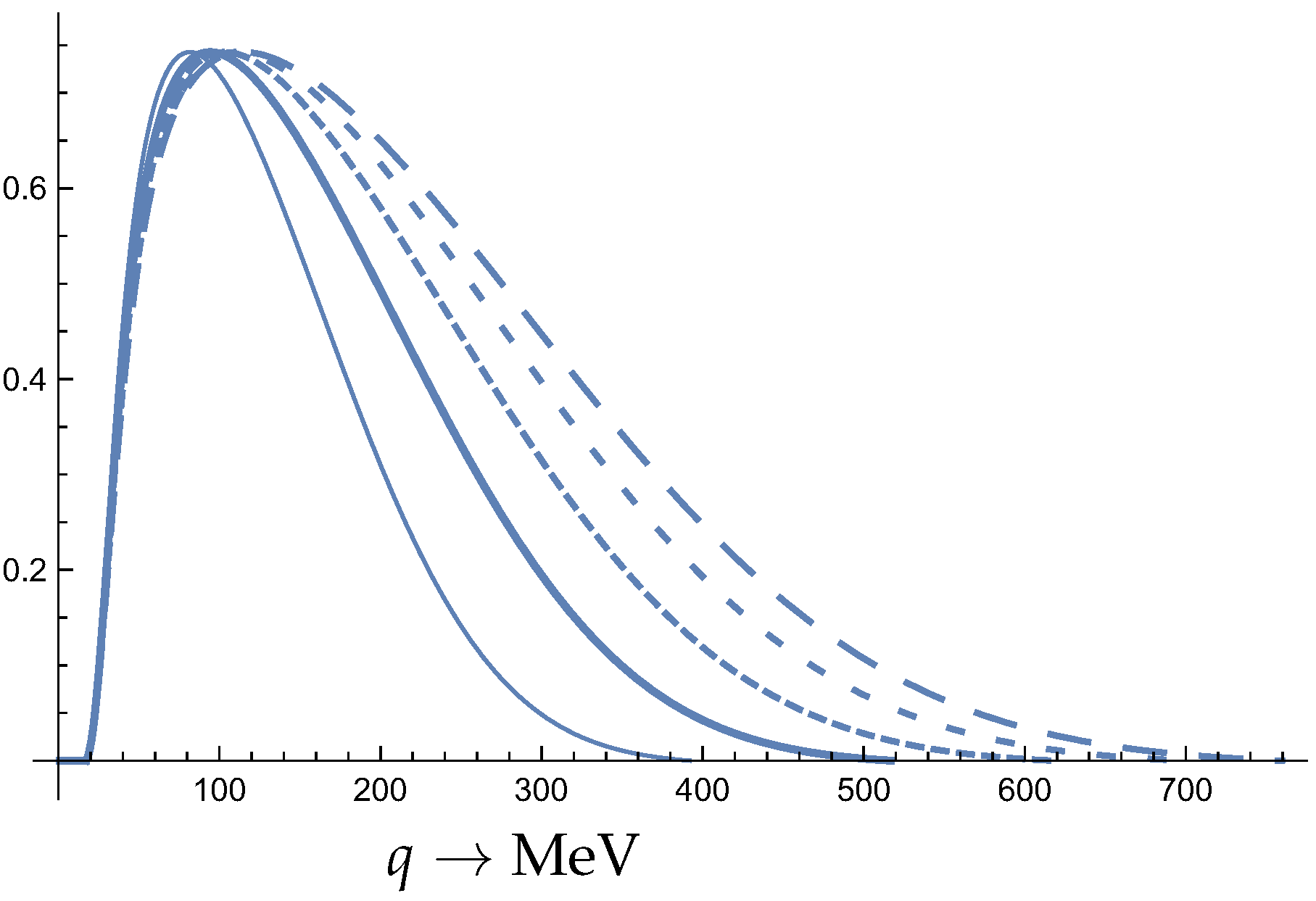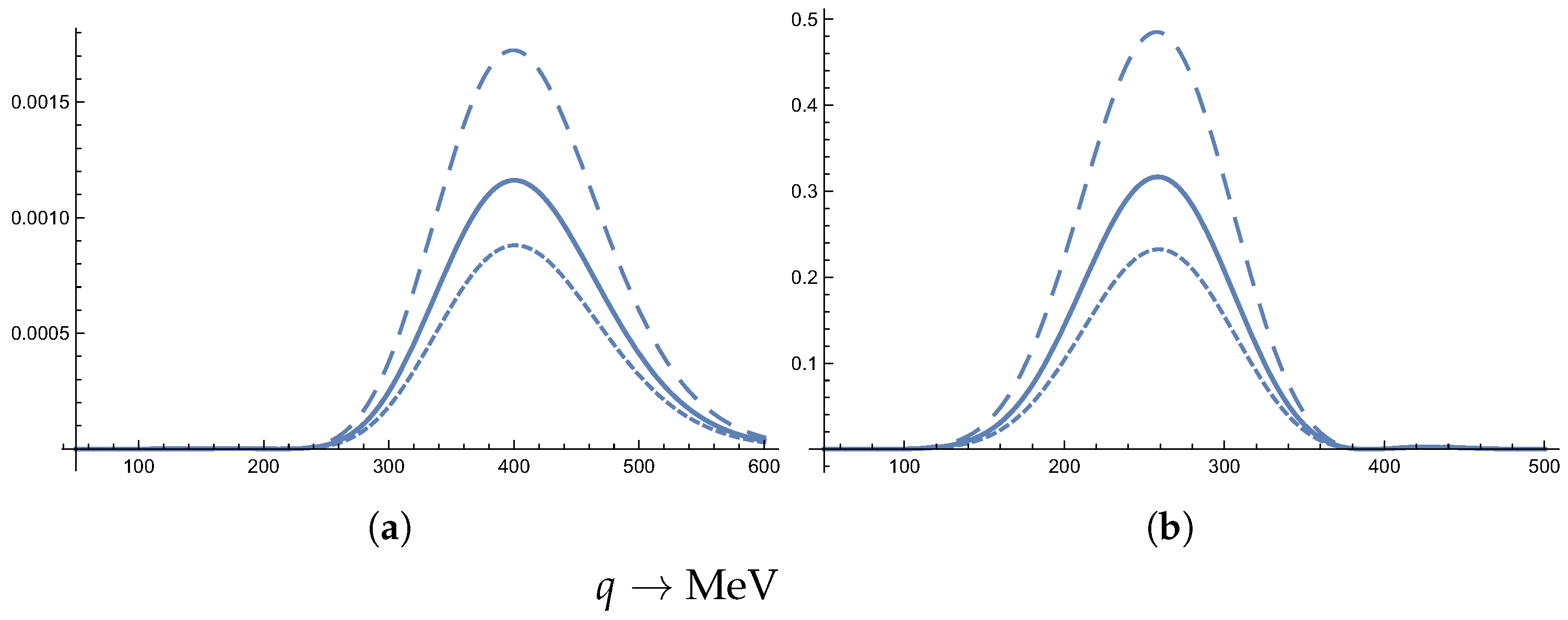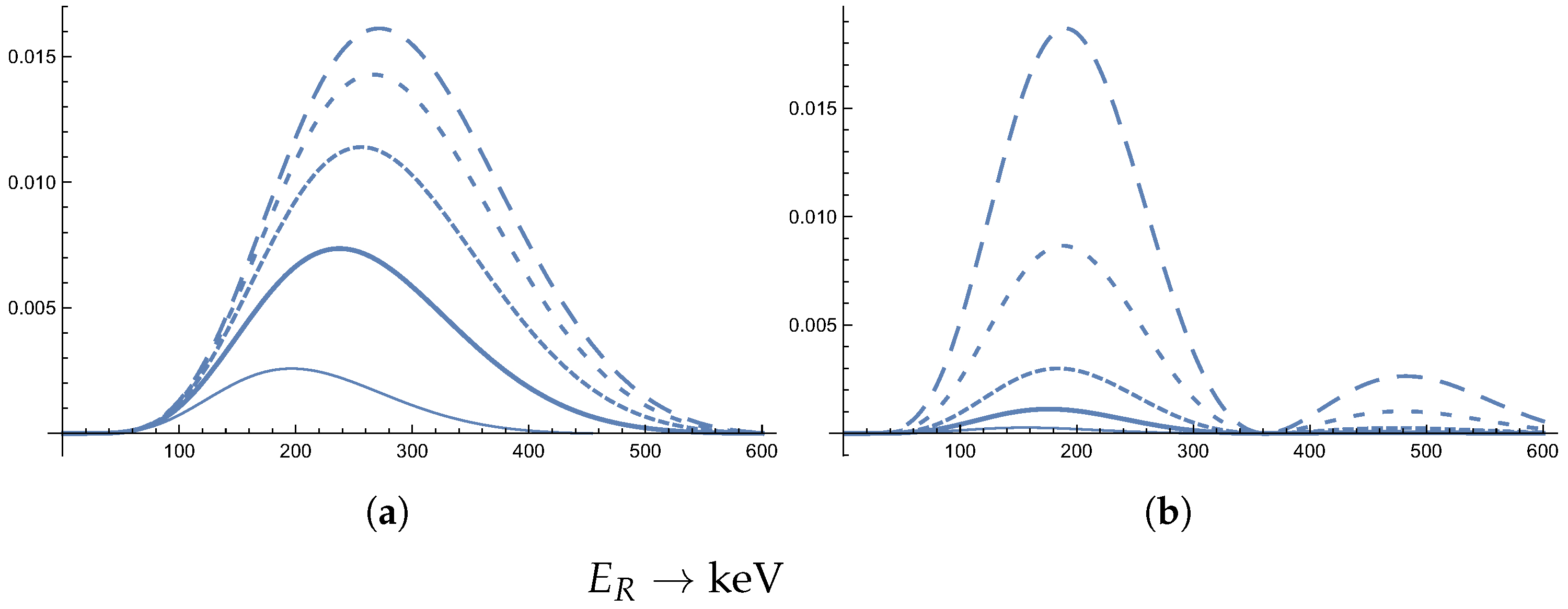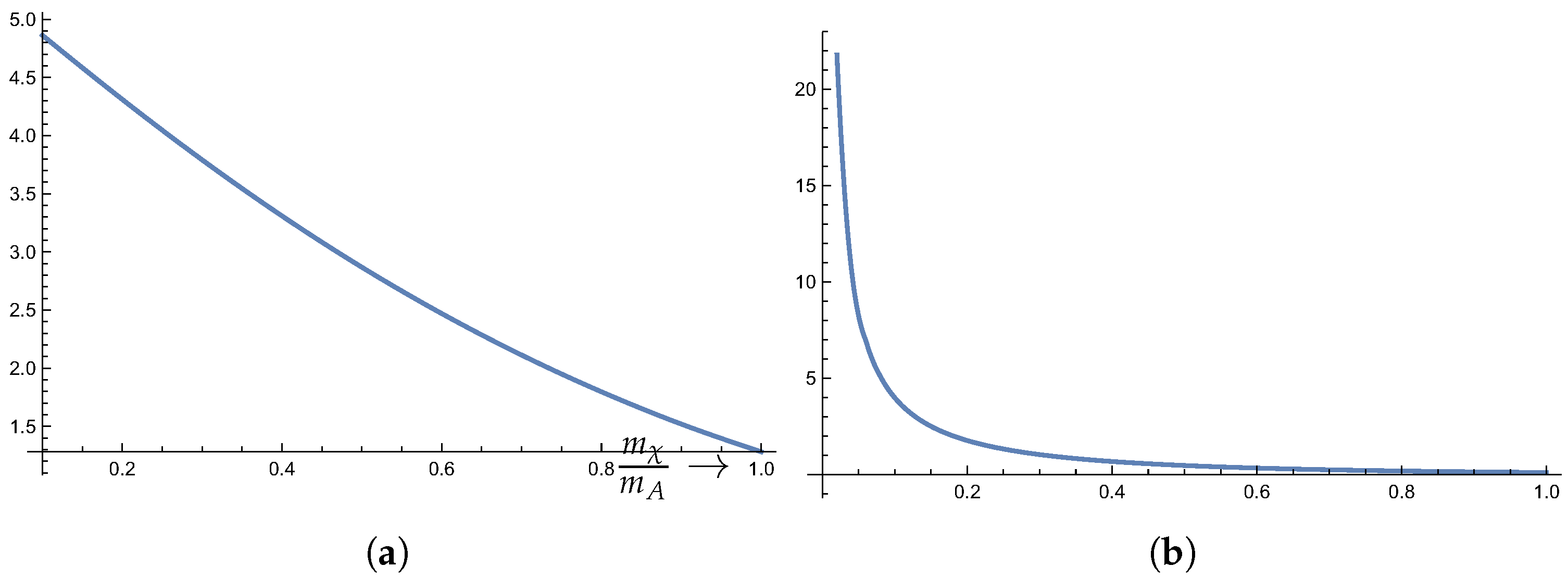Theoretical WIMP–Nucleus Scattering Rates for Isomeric Nuclei
Abstract
1. Introduction
2. Expressions for the Cross Section
3. Nuclear Structure
4. The Nucleus 180Ta
5. Some Features Regarding the Target 180Ta
5.1. Shell Model Form Factors
5.2. Phenomenological Form Factors
5.3. Some Results for 180Ta
6. Discussion
Author Contributions
Funding
Data Availability Statement
Acknowledgments
Conflicts of Interest
References
- Halverson, N.W.; Leitch, E.M.; Pryke, C.; Kovac, J.; Carlstrom, J.E.; Holzapfel, W.L.; Dragovan, M.; Cartwright, J.K.; Mason, B.S.; Padin, S.; et al. Degree angular scale interferometer first results: A measurement of the cosmic microwave background angular power spectrum. Astrophys. J. 2002, 568, 38. [Google Scholar] [CrossRef]
- Smoot, G.F.; Bennett, C.L.; Kogut, A.; Wright, E.L.; Aymon, J.; Boggess, N.W.; Cheng, E.S.; De Amici, G.; Gulkis, S.; Hauser, M.G.; et al. Structure in the COBE differential microwave radiometer first-year maps. Astrophys. J. 1992, 396, L1–L5. [Google Scholar] [CrossRef]
- Spergel, D.N.; Bean, R.; Doré, O.; Nolta, M.R.; Bennett, C.L.; Dunkley, J.; Hinshaw, G.; Jarosik, N.E.; Komatsu, E.; Page, L.; et al. Three-year Wilkinson Microwave Anisotropy Probe (WMAP) observations: Implications for cosmology. Astrophys. J. Suppl. 2007, 170, 377. [Google Scholar] [CrossRef]
- Ade, P.A.R.; Aghanim, N.; Armitage-Caplan, C.; Arnaud, M.; Ashdown, M.; Atrio-Barandela, F.; Aumont, J.; Baccigalupi, C.; Banday, A.J.; Barreiro, R.B.; et al. Planck 2013 results. XVI. Cosmological parameters. arXiv 2013, arXiv:1303.5076. [Google Scholar]
- Cui, X.; Abdukerim, A.; Chen, W.; Chen, X.; Chen, Y.; Dong, B.; Fang, D.; Fu, C.; Giboni, K.; Giuliani, F.; et al. Dark matter results from 54-ton-day exposure of PandaX-II experiment. Phys. Rev. Lett. 2017, 119, 181302. [Google Scholar] [CrossRef] [PubMed]
- Aprile, E.; Aalbers, J.; Agostini, F.; Alfonsi, M.; Althueser, L.; Amaro, F.D.; Antochi, V.C.; Angelino, E.; Arneodo, F.; Barge, D.; et al. Light dark matter search with ionization signals in XENON1T. Phys. Rev. Lett. 2019, 123, 251801. [Google Scholar] [CrossRef] [PubMed]
- Aprile, E.; Aalbers, J.; Agostini, F.; Alfonsi, M.; Althueser, L.; Amaro, F.D.; Antochi, V.C.; Angelino, E.; Arneodo, F.; Barge, D.; et al. Search for light dark matter interactions enhanced by the Migdal effect or Bremsstrahlung in XENON1T. Phys. Rev. Lett. 2019, 123, 241803. [Google Scholar] [CrossRef] [PubMed]
- Agnese, R.; Aralis, T.; Aramaki, T.; Arnquist, I.J.; Azadbakht, E.; Baker, W.; Banik, S.; Barker, D.; Bauer, D.A.; Binder, T.; et al. Search for low-mass dark matter with CDMSlite using a profile likelihood fit. Phys. Rev. D 2019, 99, 062001. [Google Scholar] [CrossRef]
- Arbey, A.; Mahmoudi, F. Dark matter and the early Universe: A review. Prog. Part. Nucl. Phys. 2021, 119, 103865. [Google Scholar] [CrossRef]
- Vergados, J.D.; Avignone, F.T., III; Pirinen, P.; Srivastava, P.C.; Kortelainen, M.; Suhonen, J. Theoretical direct WIMP detection rates for transitions to the first excited state in 83Kr. Phys. Rev. D 2015, 92, 015015. [Google Scholar] [CrossRef]
- Pospelov, M.; Rajendran, S.; Ramani, H. Metastable nuclear isomers as dark matter accelerators. Phys. Rev. D 2020, 101, 055001. [Google Scholar] [CrossRef]
- Smirnov, M.; Yang, G.; Novikov, Y.; Vergados, J.; Bonatsos, D. Direct WIMP detection rates for transitions in isomeric nuclei. Nucl. Phys. B 2024, 1005, 116594. [Google Scholar] [CrossRef]
- Bonatsos, D.; Sobhani, H.; Hassanabadi, H. Shell model structure of proxy-SU (3) pairs of orbitals. Eur. Phys. J. 2020, 135, 710. [Google Scholar] [CrossRef]
- Pritychenko, B.; Birch, M.; Singh, B.; Horoi, M. Tables of E2 transition probabilities from the first 2+ states in even–even nuclei. At. Data Nucl. Data Tables 2016, 109, 1–139, Erratum in At. Data Nucl. Data Tables 2017, 114, 371–374. [Google Scholar] [CrossRef]
- Nilsson, S.G.; Ragnarsson, I. Shapes and Shells in Nuclear Structure; Cambridge University Press: Cambridge, UK, 1995. [Google Scholar]
- Bonatsos, D.; Karakatsanis, K.; Martinou, A.; Mertzimekis, T.; Minkov, N. Microscopic origin of shape coexistence in the N = 90, Z = 64 region. Phys. Lett. B 2022, 829, 137009. [Google Scholar] [CrossRef]
- Bonatsos, D.; Karakatsanis, K.E.; Martinou, A.; Mertzimekis, T.J.; Bonatsos, N.M.; Karakatsanis, K.E.; Martinou, A.; Mertzimekis, T.J.; Minkov, N. Islands of shape coexistence from single-particle spectra in covariant density functional theory. Phys. Rev. C 2022, 106, 044323. [Google Scholar] [CrossRef]
- Minkov, N.; Bonneau, L.; Quentin, P.; Bartel, J.; Molique, H.; Ivanova, D. K-isomeric states in well-deformed heavy even-even nuclei. Phys. Rev. C 2022, 105, 044329. [Google Scholar] [CrossRef]
- Patial, M.; Arumugam, P.; Jain, A.K.; Maglione, E.; Ferreira, L.S. Nonadiabatic quasiparticle approach for deformed odd-odd nuclei and the proton emitter 130Eu. Phys. Rev. C 2013, 88, 054302. [Google Scholar] [CrossRef]
- Lehnert, B.; Hult, M.; Lutter, G.; Zuber, K. Search for the decay of nature’s rarest isotope 180MTa. Phys. Rev. C 2017, 95, 04436. [Google Scholar] [CrossRef]





Disclaimer/Publisher’s Note: The statements, opinions and data contained in all publications are solely those of the individual author(s) and contributor(s) and not of MDPI and/or the editor(s). MDPI and/or the editor(s) disclaim responsibility for any injury to people or property resulting from any ideas, methods, instructions or products referred to in the content. |
© 2024 by the authors. Licensee MDPI, Basel, Switzerland. This article is an open access article distributed under the terms and conditions of the Creative Commons Attribution (CC BY) license (https://creativecommons.org/licenses/by/4.0/).
Share and Cite
Vergados, J.D.; Bonatsos, D. Theoretical WIMP–Nucleus Scattering Rates for Isomeric Nuclei. Particles 2024, 7, 810-817. https://doi.org/10.3390/particles7030048
Vergados JD, Bonatsos D. Theoretical WIMP–Nucleus Scattering Rates for Isomeric Nuclei. Particles. 2024; 7(3):810-817. https://doi.org/10.3390/particles7030048
Chicago/Turabian StyleVergados, John D., and Dennis Bonatsos. 2024. "Theoretical WIMP–Nucleus Scattering Rates for Isomeric Nuclei" Particles 7, no. 3: 810-817. https://doi.org/10.3390/particles7030048
APA StyleVergados, J. D., & Bonatsos, D. (2024). Theoretical WIMP–Nucleus Scattering Rates for Isomeric Nuclei. Particles, 7(3), 810-817. https://doi.org/10.3390/particles7030048






